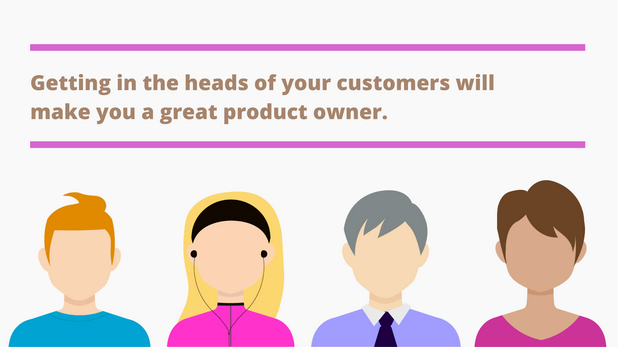
At a lot of large companies, our customers are so far out of reach that we don’t know anything about them. We don’t have any direct access to customers either, so by the time we get any real information, it’s several layers removed. It’s really common for companies to protect access to customers, but getting to know our customers likes, dislikes and preferences is a great way to ensure the products we are delivering meet their needs.
If you want to go from being a good to great product owner, we have some tips and tricks for you to better understand and empathize with your customers.
Identify User Roles
The first step in understanding the different types of customers that use your product. This should be done as a collaborative effort with your Scrum team. You may want to also invite representatives from sales, marketing or customer service who may offer a different perspective.
The first step is to brainstorm any possible users of your product. Let’s say that you’re creating a mobile application for teachers to communicate with students. Set a time box, such as 10 minutes and have everyone submit as many possible ideas as they can. Remember, there are no bad ideas in brainstorming!
Some potential users for this app could be:
- Teachers
- Parents
- Elementary Students
- Secondary Students
- School Staff
- School Club Organizers
- Coaches
Next, the team should organize these roles into categories that are similar such as “Staff” or “Students”, while eliminating any duplicate roles.
Finally, the team will discuss which roles are relevant to the product. The team may need to program the app differently between parents, teachers and students, but maybe there is no need to differentiate types of students.
Write Personas
Once you’ve determined the user roles that are relevant to the development of your product, a persona is a great technique for going one step deeper into understanding that customers. Personas should also be done with your team and representatives from marketing sales and customer service, if possible.
A persona is a way to bring to life the customer by thinking about typical characteristics. Some elements that you’ll want to put into the persona are:
- Name
- Description
- Demographics
- Personal
- Goals
- What does a day in their life look like?
- Attitudes and feelings
Here’s an example for the persona of an elementary school teacher:
Tina the Teacher
Tina the Teacher works at a public elementary school. She lives in the suburbs in a middle class neighborhood and is a mother of young children herself. She loves working with children and relates better to kids than adults. She gets up really early every morning to make healthy lunches for her kids and to prepare her lesson plans for the day. She’s frustrated that she can’t see her students face-to-face and finds it difficult to effectively communicate to kids and parents with online learning.
While it may feel a bit fictional, base this persona on what you already do know about your typical customer. Some of it may be stereotypical or guesswork, but a lot of it should come from historical evidence in working with your customers in the past.
Personas should be done for all of your major user roles, and should be visible to everyone on the team and updated often as you learn more about your customers.
Create an Empathy Map
An empathy map is a way for your team to go another level deeper into understanding what your customers are thinking and feeling. To get started, you’ll want to focus the map on a specific persona. Once again, this should be done collaboratively with your team, not alone at your desk. Here are some questions to think about:
- What do they think and feel (what really counts, major preoccupations, worries and aspirations)?
- What do they see (environment, friends, what the market offers)?
- What do they say and do (attitude in public, appearance, behavior towards others)?
- What do they hear (what friends say, what boss’ say, what influencers say)?
- Pain (fears, frustrations, obstacles)
- Gain (wants/needs, measures of success, obstacles)
The empathy map activity is really helpful for product considerations and really understanding what your customers may find valuable.
Get Access to Customers
The best thing you can do, of course, is actually observe customers interacting with your product. Nordstrom did a great job of this when they built a sunglasses app in real time by talking to customers in the store. Wells Fargo nailed this when their execs went to bank branches and talked and observed customers using the ATM machine. Apple does most of its product development by talking to customers in the store.
At many companies your customers may be out of reach, but the closer you can reach them, the better you’ll be at creating products that are exactly what your customers need and value.
Lance Dacy is a Certified Scrum Trainer who’s passionate about applying Scrum beyond technology to all areas of business and life. If you’d like to become a Certified ScrumMaster®, check out the upcoming class schedule.